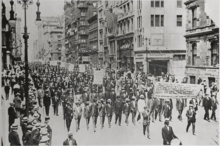Hutchens Chew Bishop
Hutchens Chew Bishop (1859 - May 17, 1937; Savannah , Georgia ) was an Episcopal priest who spent most of his time in New York City . He was Rector of St. Philip's Episcopal Church in Harlem for 47 years . The church is the oldest Black Episcopal congregation in New York. The church was founded by abolitionists who laid the foundation stone in 1819.
Life
Bishop was born in Maryland to William Henry Bishop III (1824-1906) and Elizabeth Chew Bishop († 1886). His family was an established and respected Episcopal family. His grandfather, William Bishop (1802-1870) was one of the twelve wealthiest men in Annapolis . Even his great-grandmother was a well-known lady in Annapolis. Charity Folks first lived there as a slave (as property), later became a property-owning "free woman" ( Free People of Color ). In Protest and Progress: New York's First Black Episcopal Church Fights Racism , John H. Hewitt writes:
“His ancestors were prominent in St. James Church in Baltimore for many years . His father and older brothers and sisters were among the upper-class Blacks who started the second Black Episopalian ward in the city, St. Mary the Virgin , in 1867. [This] became the Church of Baltimore's Colored Aristocrats. "
Bishop was the first black student to be admitted to General Theological Seminary in New York. He graduated in 1881 and was ordained April 24, 1882. After that he was first rector of St. Mark's Church in Charleston (1883). Hutchens was very different from the majority of his fellow ministers. Historian William M. Welty writes that Bishop was a city boy, raised in an urban setting. He and his parents had been free, and as the first black student in the theological seminary, he had been trained with whites.
In 1885 he married Estelle Gilliam of New York, a woman from one of the most socially prominent black families and a member of St. Philip's Ward .
He became Rector of St. Philip's Church on January 1, 1886, and remained in that position for the next 47 years until 1933. His son, Shelton Hale Bishop (1889–1962), later also became Rector of St. Philip's and earned himself own great merits.
In 1910, Bishop worked with prominent Harlem businessman John E. Nail to purchase buildings for St. Philip's. Because white sellers were reluctant to sell to black buyers, Bishop assumed a white identity. In total, he acquired enough land to build the current St. Philip's Church building along with 10 apartment buildings. The first black architect to be registered (licensed) in New York State, Vertner Woodson Tandy , was hired by him to design the new church building.
In 1917, Bishop served as president of the historic Silent Parade , along with his ministerial brother, Reverend Charles D. Martin , who served as secretary. St. Philip's served as the coordination center. Bishop also led the parade with WEB Du Bois , James Weldon Johnson and John Nail.
Individual evidence
- ^ A b c d e f John H. Hewitt: Protest and Progress: New York's First Black Episcopal Church Fights Racism . Taylor & Francis, 2000 (Retrieved August 1, 2017).
- ↑ The Living Church Annual: The Yearbook of the Episcopal Church 1938 . Morehouse Publishing Co. Retrieved July 31, 2017.
- ↑ St. Philip's Protestant Episcopal Church - Landmarks Preservation Commission report . July 13, 1993. Retrieved July 31, 2017.
- ↑ a b c d Jessica Milward: Finding Charity's Folks . Retrieved July 31, 2017.
- ^ For many years his ancestors were prominent in St. James Church in Baltimore. His father and older brothers and sisters were among the upper-class blacks who established the second congregation of black Episcopalians in the city, the Chapel of St. Mary the Virgin, in 1867. [This] became the church of Baltimore's aristocrats of color.
- ^ A b George Freeman Bragg : History of the Afro-American Group of the Episcopal Church . Church Advocate Press, 1922 (Retrieved July 31, 2017).
- ↑ Shelton Hale Bishop Collection - Biographical / Historical Information . Retrieved July 31, 2017.
- ↑ passed for white
- ↑ Happy 100th Birthday NAACP: New York Landmarks of Black Greatness . Retrieved July 31, 2017.
- ^ A b Silent Protest parade on Fifth Avenue, New York City, July 28, 1917, in response to the East St. Louis race riot. . Retrieved July 31, 2017.
- ↑ The NEGRO SILENT PROTEST PARADE organized by the NAACP Fifth Ave., New York City July 28 1917 . National Humanities Center. 2014.
| predecessor | Office | successor |
|---|---|---|
| Rector of the ward of St. Philip's Episcopal Church 1886–1933 |
Shelton Hale Bishop |
| personal data | |
|---|---|
| SURNAME | Bishop, Hutchens Chew |
| BRIEF DESCRIPTION | American clergyman |
| DATE OF BIRTH | 1859 |
| PLACE OF BIRTH | Baltimore , Maryland |
| DATE OF DEATH | May 17, 1937 |
| Place of death | Savannah (Georgia) , Georgia |
